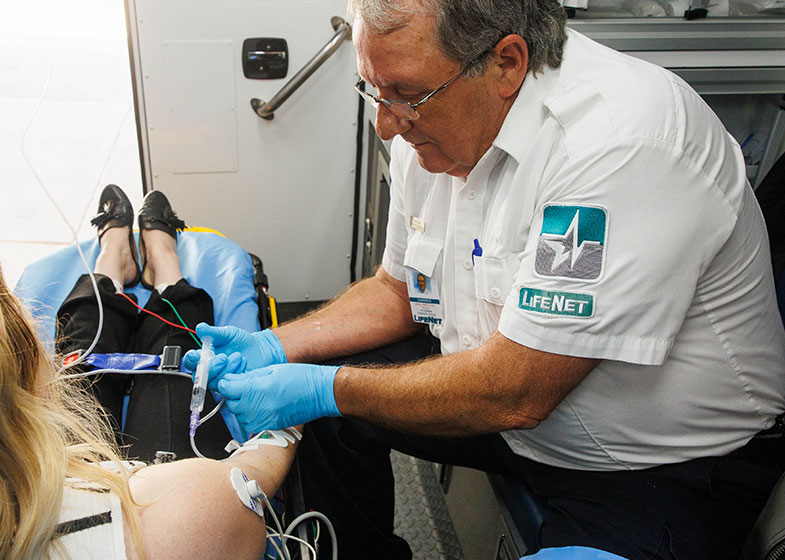Dedicated to
Serving You
LifeNet, Inc., has the resources and willingness to file your primary insurance. As a courtesy, we are happy to make reasonable efforts to help you receive reimbursement for insurance or other third party programs to which you belong. However, payments of fees are the patient’s responsibility and the success (or lack of success) in securing reimbursement from a third party does not lessen your obligation to pay LifeNet promptly.

Our terms are cash or insurance. Questions regarding financial matters should be directed to our Business Office (903-832-8531) who will be happy to work with you on such matters.
Due to federal regulations we cannot waive any co-pays. The Business Office will assist with insurance filing and appeals, and account resolution.
LifeNet is a not-for-profit corporation. We receive no direct grants or funds from any governmental agency except those programs which are open to all ambulance providers and make reimbursements for services actually rendered, such as Medicare, Medicaid, Champus, State Rehabilitation, etc. Government and State programs do not reimburse the full amount of charges.
LifeNet is committed to conducting its business in a lawful and ethical manner. We comply with all applicable federal, state and local laws
Forms & Resources
The following forms and documents are made available to assist our patients in obtaining their records and to gain a better understanding of their patient rights. Documents are available in Adobe Acrobat (PDF).
Completed forms can be faxed to 903-832-0215
Insurance Term Glossary
An agreement in which you instruct your insurance organization to pay the hospital, physician or medical supplier directly for your medical services. Your insurance organization decides the payment rate.
The amount owed to LifeNet indicated on the billing statement.
Debt incurred for medical service a health care provider or medical facility provided.
Private or employer base health insurance.
An amount established by the insurance company as the patient’s responsibility of billed fees.
How insurance organizations determine the primary payment source when you’re covered under more than one insurance organization or group medical plan. Your insurance contract states that if you are covered under more than one insurance plan, benefits will be coordinated so that total benefits paid will not be more than 100% of the bill. COB for children covered by both parents is determined by the parent with the earliest birthday (month and day only) in a calendar year.
Specific services or supplies for which your insurance reimburses you or pays your health care provider. These consist of a combination of mandatory and optional services and vary by insurance benefit plan.
An amount determined by the insurance company to be paid on an annual basis before benefits are paid to the provider.
A document provided by the patient’s insurance plan/Medicare detailing how benefits are processed and paid for services rendered.
The person responsible for paying the bill.
A service not covered under the limits of the patient’s health insurance contract. These amounts are the patient’s responsibility to pay. Patients should direct questions about coverage to their insurance plan.
A health care provider who isn’t under contract with an insurance organization to accept patients and receive the insurance organizations approved amount on all claims. (You pay the difference between its approved amount for a service and this health care provider’s charge.)
A health care provider who contracts with an insurance organization to accept patients and receive the insurance organizations approved amount on all claims.
Requirement of your insurance company to determine medical necessity for services rendered. Pre-certification does not guarantee benefits for payment. Benefits are based on policy provisions in force at the time services are rendered. Questions about pre-certification requirements in your contract should be directed to your insurance plan.
The insurance organization with first responsibility for paying eligible insurance expenses for your medical service (after you have paid your deductible, co-payments, etc.). Your secondary or other insurance (if you have other insurance) would work with your primary insurance organization to cover eligible expenses according to your insurance policies.
A valid insurance card including the address where claims are to be filed.
The insurance organization with second responsibility for paying eligible insurance expenses for your medical service (after you have paid your deductible, co-payments, etc.). This insurance (if you have it) would work with your primary insurance organization to cover eligible expenses according to your insurance policies. This insurance organization is billed second – after your primary insurance organization has been billed and processed your claim.
A record of account status sent to patients monthly to advise of the previous period’s transactions and activity on the account.
The insurance organization with third responsibility for paying eligible insurance expenses for your medical service (after you have paid your deductible, co-payments, etc.). This insurance (if you have it) would work with your primary and secondary insurance organizations to cover eligible expenses according to your insurance policies. This insurance organization is billed third – after your primary and secondary insurance organizations have been billed and processed your claim.
A patient without medical insurance.
Privacy Policy
Patients can expect their privacy will be protected and patient specific information will be released only to persons authorized by law or by the patient’s written consent. No LifeNet employee has a right to any patient information other than that necessary to perform his or her job. View our privacy policy.
